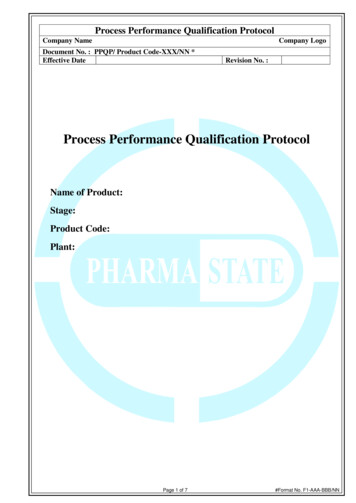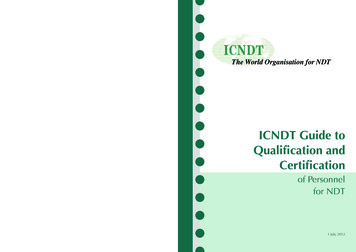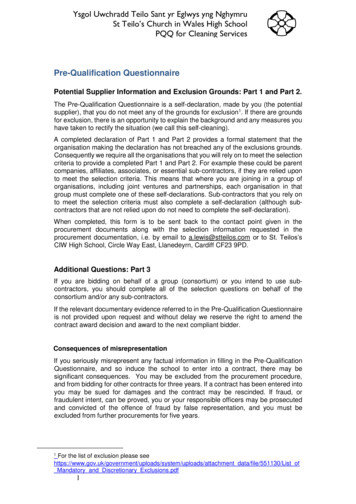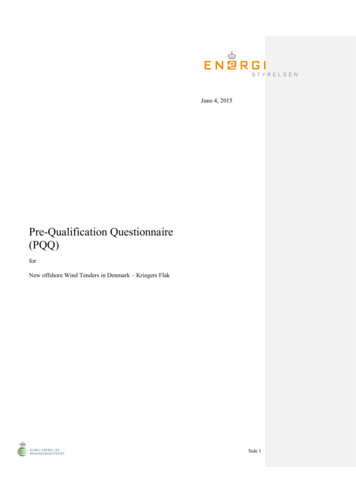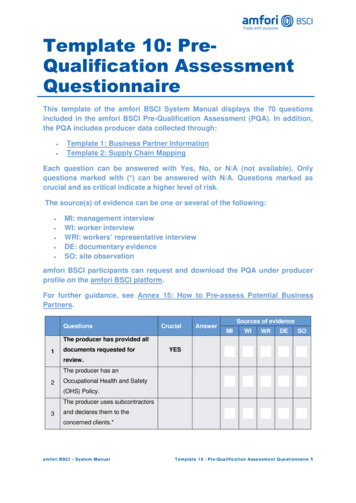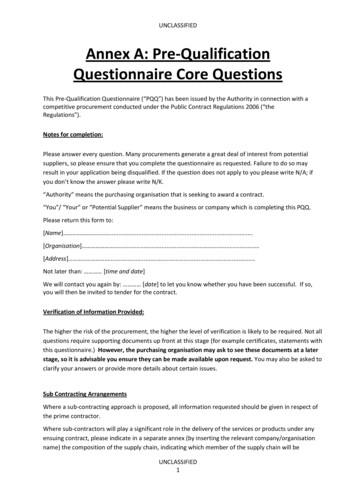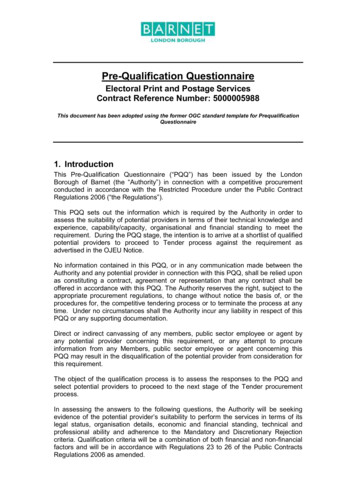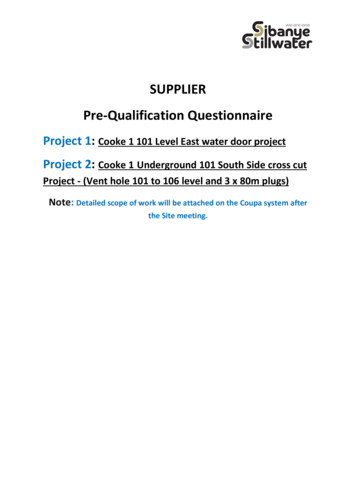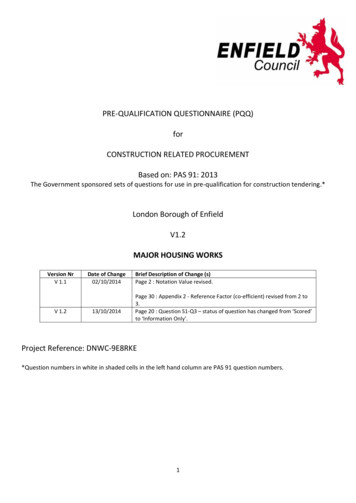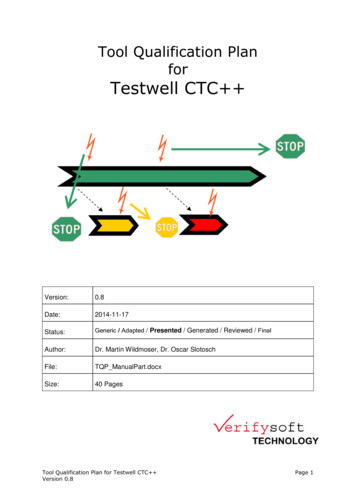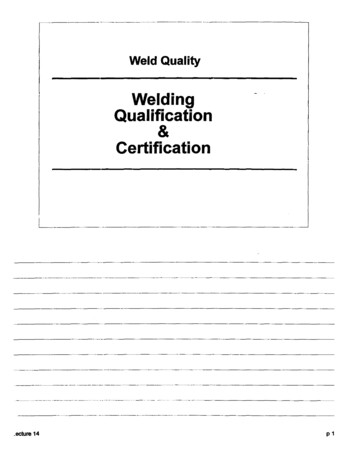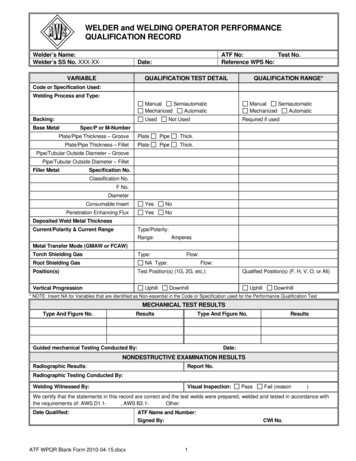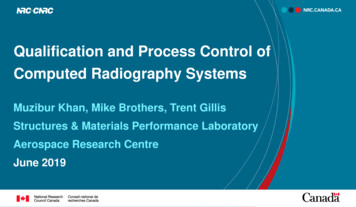
Transcription
Qualification and Process Control ofComputed Radiography SystemsMuzibur Khan, Mike Brothers, Trent GillisStructures & Materials Performance LaboratoryAerospace Research CentreJune 2019
Outline of Presentation Film vs Digital Radiography Introduction of Computed Radiography (CR) Qualification & Process Control of CR (ASTM E2445) CR for High Resolution Applications Summary2
Objectives of the Study Qualification of CR systems in accordance with ASTM E2445 standards Investigation of EPS concepts for aluminum alloy Baseline EPS performance of CR system/Imaging Plates Estimation of minimum, range, linearity of exposure Developing process control of CR imaging applications To ensuring a high degree of repeatability of inspection results Investigation of CR for high resolution applications3
Background: Film vs Digital Radiography Film for NDT applications is gradually diminishing (time, cost,hazardous chemical, lack of digital advantage) Digital Radiography (DR/CR) allow faster/easier image acquisition DR/CR Widespread application still poses significant challenges Initial cost of system, Steep learning curve Lack of procedure to choose parameters Lack of demonstrated system performance Performance assessment required (If CR/DR can effectively provideequal or better performance than the existing film-based technology)4
Computed Radiography (CR)Ref: www.ndt-ed.orgRef: Korner, M., “Advances in DigitalRadiography” CR uses a reusable phosphor imaging plate and allows faster image acquisition digitally,improved capabilities for analysis and digital storage5
Contrast in CR In general CR has better “latitude” than film CR can cover a wide range of thicknesses/densities in a single exposureDigital LatitudeSection 1 – The ImagePlateCRfilmCRFilm LatitudePixelvalueorfilmdensity CR has better contrast sensitivity (CS)i.e. Capability to “window/level” to visualize a contrast stepFilmExposureRef: Digital and Film RadiographyComparison - Ken LaCivita1%2%3%4%
Primary Metrics for Image Quality in CR Primary metrics for establishing the performance are Signal-to-Noise Ratio (SNR) Contrast-to-Noise Ratio (CNR) Basic Spatial Resolution (SRb) Higher the SNR, CNR or smaller the SRb, better the quality In film radiography (RT) these are evaluated indirectly by imageSNR 226.273quality indicators (IQI) No direct relationship between radiographic sensitivity and flaw size(SRb)(CNR) 27
NRC Computed Radiography Computed radiographic system (SR 70 µm, HR 35 µm) Table-top flatbed scanner with contactless plate transport, inline erasure 16 Bit, Scan width 14”, Throughput 90 plates/hr (SR), 28 plates/hr (HR) CR image acquisition/analysis software (DICONDE compliant HR & medium speed (IPS) and extreme HR and slow speed imaging plates (IPU) BAM certified highest system Class IP 1 / 80 according to ISO 16371-1 and ASTM E24468
ASTM E 2445M-14 (Phantom)(Practice for Qualification and Long Term Stability of CR Systems) Spatial Resolution and Unsharpness – Converging Line Pair Contrast Sensitivity (Contrast-to-Noise Ratio CNR) Spatial Resolution and Unsharpness – Duplex Wire Geometric Distortion Laser Beam Function Blooming or flare Slippage Shading IP Linearity Signal-to-Noise Ratio (SNR) EPS (Either SNR or EPS)9
Basic Spatial Resolution (SRB) (Duplex Wire Gauge) SRB - ability to clearly see abrupt changes in an object, resolve/separate smaller featuresFilm has better SRB (Film grain 0.6-0.8µm vs CR IP grain 3-5µm, scanning res., others)Duplex Wire IQI in accordance with ASTM E2597Resolution is determined by the first unresolved wire pair (modulation depth 20%)Profile line requires parallel to gauge and positon/width of line have effect on BSRBest result – IPU (blue plates) and lower scanning sampling rate (scanning time /exposure)Line Profile in Duplex Wire GaugeDuplex Wire GaugeRef kowtest.com10
Basic Spatial Resolution (BSR) (Line Pair Gauge)Fast Scan Direction 4.25 lp/mm 125 Micron Discrepancy in BSR (DW vs. LP) Human Factor, Aliasing ASTM E2445 lacks in instructionSlow Scan Direction 5.3 lp/mm (100 Micron)11
Contrast Sensitivity /Contrast-to-Noise Ratio (CNR) Ability to detect variations in thickness/densityVisual evaluation of targets Al, Cu, SteelCNR often requires 2 - 2.5 (TBD)2% sensitivity was observed even when CNR 2Automated procedure showed inconsistencies in CNRContrast sensitivity is key for low res. Application (e.g. composite)12
Signal-to-Noise Ratio (SNR) / Normalized SNR (SNRN) SNR - Quantitative indication of noise level (Scatter, quantum nature of photon, IP inherent structure, PMT Gain, Laser Power, etc.), higher theSNR, the less obtrusive the background noise Normalization by the effective pixel size gives an SNRN (Independent of SRB) SNR were found varied with size and location of Region-of-Interest (ROI) In general CR is more sensitive to scatter than film Pre-filters, screens, collimator, short exposure may reduce scatteris measured SNRis basic spatial resolutionSNR 226.273Ref: Digital and Film Radiography - Ken LaCivita13
BAM Snail for Central Beam Alignment Radiation beam aligned perpendicular to the center of the (BAM-Snail) CR image of the image quality indicator will be a regular spiralRef: ASTM E2445Central beam alignment @ 70 µmCentral beam alignment @ 35 µm14
Laser Beam Jitter Jitter appears if the laser beam function is not working properly (lack of smooth movement ofthe imaging plate/laser scanning device) Dust on the laser or mirror is the probable causes of laser malfunction Examining the edges of the “T-bar” on the image Target edges should be straight and continuousExamining edge of T-beamImage with jitter (sample)Ref: LaCivita, K.J, “AFRL-RX-WP-TR-2009-4069Image without Jitter (NRC)15
Geometric Distortion Checks the spatial linearity of the CR system to find image distortionRuler of high absorbing materials located in the perimeter (x- and y- direction)Tilting / twisting of IP during the scanMaximum geometric distortion was found 0.045% [Require 5%]16
Shading Effect Ensure scanning laser intensity is uniform across scanning width of IPCheck for proper alignment of light-guide/photo-multiplier tube assemblyASTM E2445 15%, Centre hole vs. Corner hole )NRC 1%, 8% and 3%, 1%17
Scan Column Dropout No test object required Obserable as zero pixel value linear image artifact Straight bright white line parallel to the transport direction Probable cause is internal obstruction (e.g. contaminates]Sample image with scan column dropoutRef: ASTM E2445M-14No scan column dropout white line (NRC study)18
Scanner slippage Slipping of an IP in a scanner transport system Slipping would result in deviations in the intensity of scanned lines Distortion in homogeneity of scanning/reading system Deviation showed as intensity is greater than the system noiseSample Image with SlippingRef: LaCivita, K.J, “AFRL-RX-WP-TR-2009-4069”19
Blooming or Flare or Afterglow Overshoot or streaking (dark shadow immediately adjacent of a high density target)IP oversaturated around target may leave a latest image or ghostShould not be visible, BAM okay 1.5 %, NRC no bloomingNeed to perform again with changed settings (High / Low PMT Gain)May require use of shielding or rotate IP to prevent local “blooming” artifacts and/orlatent imagesNRC Experiment (No blooming)Sample Image with bloomingRef: LaCivita, K.J, “AFRL-RX-WP-TR-2009-4069”20
Image Artifacts (Ghost) Unwanted image features (unanticipated and unexplainable ) Hardware, cracked plates, laser beam head, wear/scratch or moisture Harm the quality and may obscure the area of interest Few artifacts were attributable to residual permanent image ofreference specimen. High exposure in unshielded part of IP plate, scatter radiation, etc.which eventually contributed to form a hard to erase latent image Erasure test can help to determine if erasure is adequate Masking unexposed part with lead and additional erasure cycles arefew options to remedy latent image21
Equivalent Penetrameter Sensitivity (EPS)EPS plaques discern subtle differences in image quality as radiographic parameters are changedDetermine the exposure levels necessary to ensure an adequate signal-to-noise ratio (SNR)Generate the acceptable gray value working range of the CR system and IP plate combinationEPS is a subjective test (Related to inspector eye capability to view & count no. of visible holes)EPS curve is used for establishing & monitoring critical process control metric of CR/IP/procedureEPS is inversely proportional to SNR (See ASTM E2445 or E746 for details)Equivalent Penetrameter Sensitivity (EPS)Equivalent Penetrameter Sensitivity au0.80%EPS @15 HoleEPS @20 Hole0.60%EPS %EPS % EPS @15 HoleEPS @20 0%01000200030004000Exposure mA-S5000600070001000020000300004000050000Pixel Value (PV)22
Pixel Value LinearityLinearity of Pixel Value with Exposure Signal//Pixel value required to be proportional to50000the radiation dose or exposure40000 Data point is within 10% of a straight line best fit35000Pixel Value ASTM E2445 lacks in guidelineR² 0.9886450003000025000PV20000Linear posure mA-s23
CR Comparison (Electronic Board)SpecimenFilmCR24
Film vs CR (Sandwich honeycomb core panel cupper meshSpecimenFilmCR25
CR for High Resolution Application (Cracks, Weld Defects) Much more challenging to match detection limits of film! Should have good contrast sensitivity Spatial resolution and image noise are also critical Spatial resolution (primarily affected by sampling rate or scanning resolution (100µm, 50µm,25µm), imaging plate grain size Image noise primarily affected by imaging plate characteristics, exposure (mA x time)FilmCR26
Film vs CR (Nozzle Guided Vane)SpecimenFilmCR27
Summary SNRN exceeded the ASTM highest system class (130 IP special) Resolution, contrast, SNR, shading, beam alignment, jitter, slippage, geometricdistortion etc.) met the current ASTM requirements SNR or EPS improves with exposure up to certain point. Best image resolution – blue plates & lower scanning resolution Ghosting-like artifacts were observed which required engineering judgement toovercome EPS curve is not typical but identify min. exposure (key requirement) CR image is not the same as film, many variables affect image quality and manyunique phenomena need to consider28
Thank you!Contact:Muzibur KhanSMPL, Aerospace Research CentreNational Research Council of CanadaEmail: muzibur.khan@nrc-cnrc.gc.caTel: 613-990-4733
Film for NDT applications is gradually diminishing (time, cost, hazardous chemical, lack of digital advantage) . Ref: www.ndt-ed.org Ref: Korner, M., “Advances in Digital Radiography” Contrast in CR In general CR has better “latitude” than film CR can cover a wide range of thicknesses/densities in a single exposure CR has better contrast sensitivity (CS) i.e. Capability to “window .
